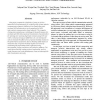Free Online Productivity Tools
i2Speak
i2Symbol
i2OCR
iTex2Img
iWeb2Print
iWeb2Shot
i2Type
iPdf2Split
iPdf2Merge
i2Bopomofo
i2Arabic
i2Style
i2Image
i2PDF
iLatex2Rtf
Sci2ools
133
Voted
ACISICIS
2005
IEEE
2005
IEEE
Performance Analysis on Mobility of Ad-Hoc Network for Inter-Vehicle Communication
This paper presents the feasibility of using an ad-hoc network as an infrastructure for a small group of inter-vehicle communication network. Mobile ad-hoc networking with wireless LAN infrastructure can be employed to build inter-vehicle communication based network. The irregular driving environment pose a challenge to the performance of a wireless LAN. We have measured transmission characteristics for sending and receiving high data volumes using TCP and UDP in vehicles moving on IEEE 802.11b. Our framework aims to evaluate the effect of our proposed mobility models on the performance of Dynamic Source Routing (DSR) based on measured data. Proposed mobility models are varied by conducting the experiments under different driving environment, driving conditions, and vehicular patterns. Our result shows that the routing protocol mechanism, such as route discovery and route maintenance, does not interrupt the data transmission seriously.
ACISICIS 2005 | Driving Environment | Information Retrieval | Inter-Vehicle Communication | Wireless Lan |
Related Content
| Added | 24 Jun 2010 |
| Updated | 24 Jun 2010 |
| Type | Conference |
| Year | 2005 |
| Where | ACISICIS |
| Authors | Jaehyun Kim, Woojin Han, Woohyuk Choi, Yunil Hwang, Taehwan Kim, Joowook Jang, Jaeyong Um, JunChae Lim |
Comments (0)

